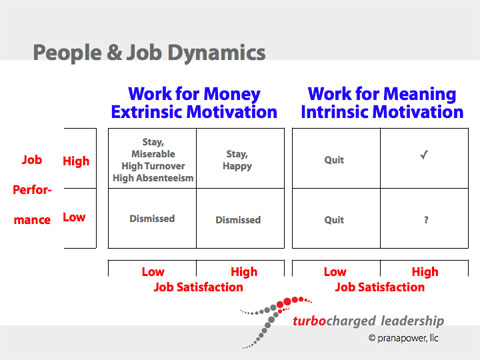Todayâs Blondie cartoon shows an example where the tyrannical boss, Mr. Dithers, tacks up a motivational poster and wonders if it will improve the performance of his workers. This cartoon, coupled with the anecdotal reports of companies raising pay to retain high performing workers, brings me to write this post explaining the relationship of three very important variables all leaders should understand.
Looking at our first variable, most leaders want team members who consistently perform at a high level, that is, having high job performance.
This begs the question of the second variableâhow to motivate workers to perform at that level. Roughly three decades of research from the 1960s to â80s have settled in on the concept of intrinsic and extrinsic motivation. It was found that a segment of workers is motivated intrinsically, that is by challenges, promotions, and creating compelling products. Think Steve Jobs and his concept of putting a âdent in the universe.â Individuals, such as engineers and programmers are generally intrinsically motivated. They desire to create the next breakthrough product or service. As for extrinsic motivation, we frequently hear of sales people being extrinsically motivated by commissions, bonuses, and year-end trips and parties.
An important element in your success as a leader is to understand how your particular team members are motivatedâextrinsically or intrinsically. Some of the research has shown that extrinsic rewards can destroy intrinsic motivation. If youâd like to read more about that, check out my previous post on motivation here.
The third variable is job satisfaction. Factors such as pay, work environment, organizational policies, and relationship with superiors make up this variable. In general, low job satisfaction drives turnover and absenteeism. Strangely enough, high job satisfaction wonât necessary motivate workers to perform better.
Having laid this foundation, letâs turn to the concept of raising pay to retain workers. Will it work? Possibly.
If a worker is extrinsically motivated, the additional money will likely have an effect on his or her performance and willingness to stay on with your organization.
However, if the worker is intrinsically motivated it will depend on the level of pay commensurate with the pay at other organizations. If you are paying less than other organizations and the worker is being motivated by challenging work, promotions, or some other intrinsic rewards, then the increased pay will likely help.
If your level of pay is on par with other organizations and you have challenging work assignments for your intrinsically motivated individuals, then you probably donât have to worry.

I frequently use the accompanying chart with organizations to explain the relationship of these three important variables. Looking at the bottom row, low job performance, we can see that low performing workers will either be dismissed or quit if their job satisfaction is also low. Iâm not sure what it means if a worker has high job satisfaction but low job performance.
For individuals performing at a high level, if they are extrinsically motivated and not satisfied with their job they may stay and feel miserable or leave. Increasing the pay of these individuals may help greatly if that is one of the factors contributing to the low job satisfaction.
If the individuals in question are intrinsically motivated, and are suffering from low job satisfaction, raising their pay is unlikely to have any lasting effect. You need to find how out what motivates them and respond appropriately.
Bottom line: talk to your team members and find out what excites them. If itâs money, fine. Otherwise, determine where their passion lies and find creative ways to plug into that energy. Thatâs leadership.
Concepts:
- Three variables are important when considering how to retain and motivate team members: motivation type, job satisfaction, and job performance
- Additional pay is likely to retain extrinsically motivated individuals if they are otherwise reasonably satisfied with their job
- Additional pay for intrinsically motivated individuals is likely to help only if they believe that they are currently underpaid and are otherwise highly motivated by challenging assignments, promotions, and other intrinsic rewards
- Additional pay is not likely to help retain workers if factors other than pay are contributing to low job satisfaction
Keywords: leadership, motivation, job performance, job satisfaction
References:
- Amabile, T. M. (1997). Motivating creativity in organizations: On doing what you love and loving what you do. California Management Review, 40(1), 39-58.
- Herzberg, F. (1968). One more time: How do you motivate employees? Harvard Business Review, 46(1), 53-62.
- Judge, T. A., Thoresen, C. J., Bono, J. E., & Patton, G. K. (2001). The job satisfaction-job performance relationship: A qualitative and quantitative review. Psychological Bulletin, 127(3), 376â407.
- Ryan, R. M., & Deci, E. L. (2000). Self-determination theory and the facilitation of intrinsic motivation, social development, and well-being. American Psychologist, 55(1), 68-78.


